The Ones That Got Away—10 Fashion Shows of the 2010s That Vogue Editors Wish They’d Seen
We’ve spent a lot of time this year discussing the fashions of the 2010s—charting trends on both the runways and the street; measuring collections against each other; and weighing in on such phenomena as leggings and the ubiquitous dad sneaker.
It’s involved a lot of reminiscing, but a fair bit of regret, too. We covered about 10,000 fashion shows in the last 10 years. That’s a lot of runways and none of us managed to see them all. We figured that the ones we’re saddest about missing most tell their own story about the decade, and indeed a quick survey of the list below points to several key developments that emerged in the 2010s: the appearance of destination shows, a much-needed turn to diversity and inclusivity; and a rising fascination with menswear. By the way, the fall 2020 men’s shows start in less than two weeks on January 4. In the meantime, read about 10 definitive shows of the 2010s that we wish we’d seen.
Rick Owens spring 2014
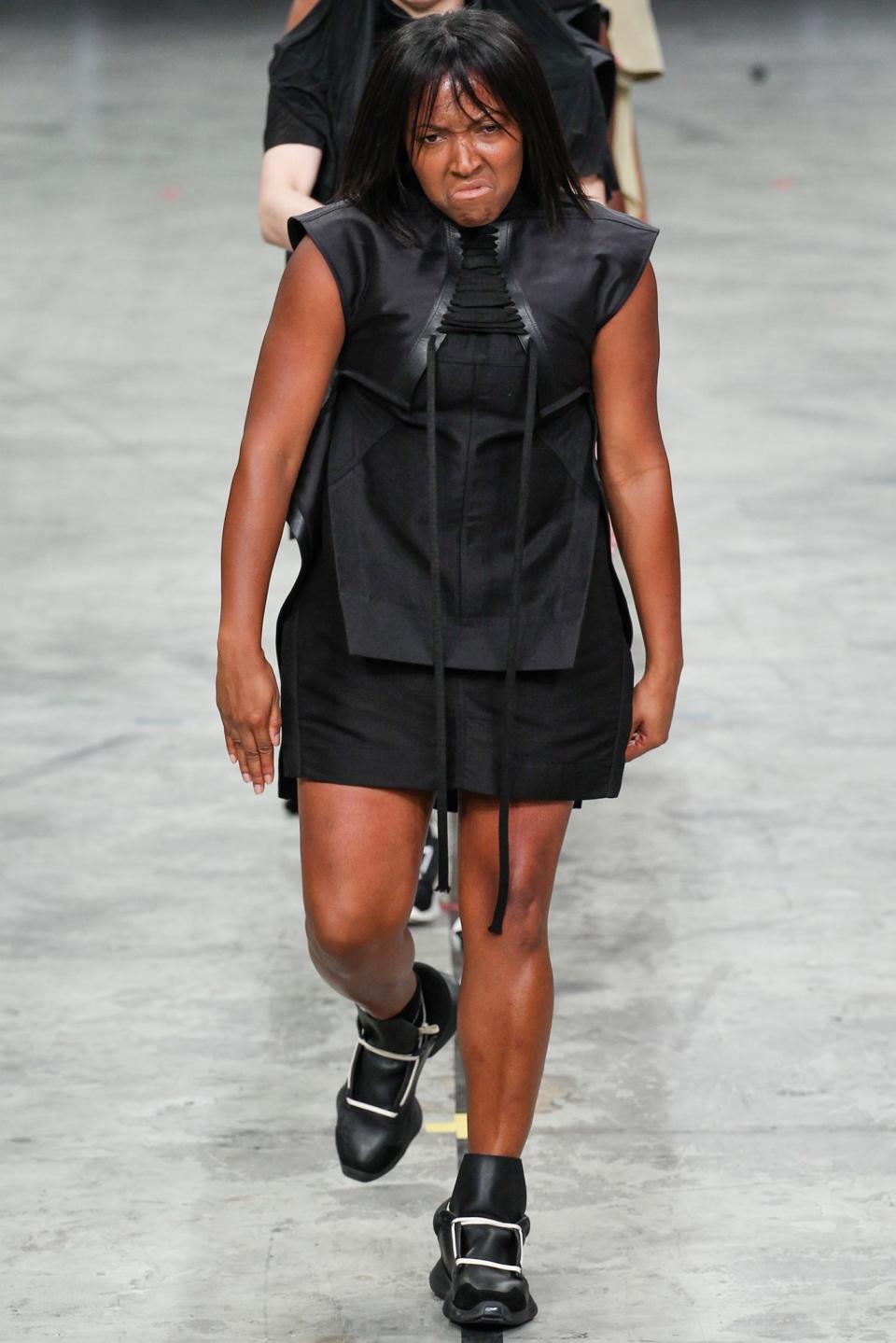
Back in 2013 the runway format was a lot stricter than it is now, less experiential. So the step dancers at this Rick Owens outing—their features set in perma-scowls called “grit face” and bodies synchronized to a backbeat—were a fabulous revelation. From the stories I heard in the show’s aftermath it was the most energizing and uplifting of fashion happenings that my colleagues had ever experienced, a celebration of fierce female power. I will kick myself in perpetuity for missing it to file some other review. As ever, Owens was ahead of his time. The inclusive vision of womanhood seen here makes the tokenism often witnessed on the runways even six years later stand out in sharp relief. —Nicole Phelps, director Vogue Runway
Martine Rose spring 2019
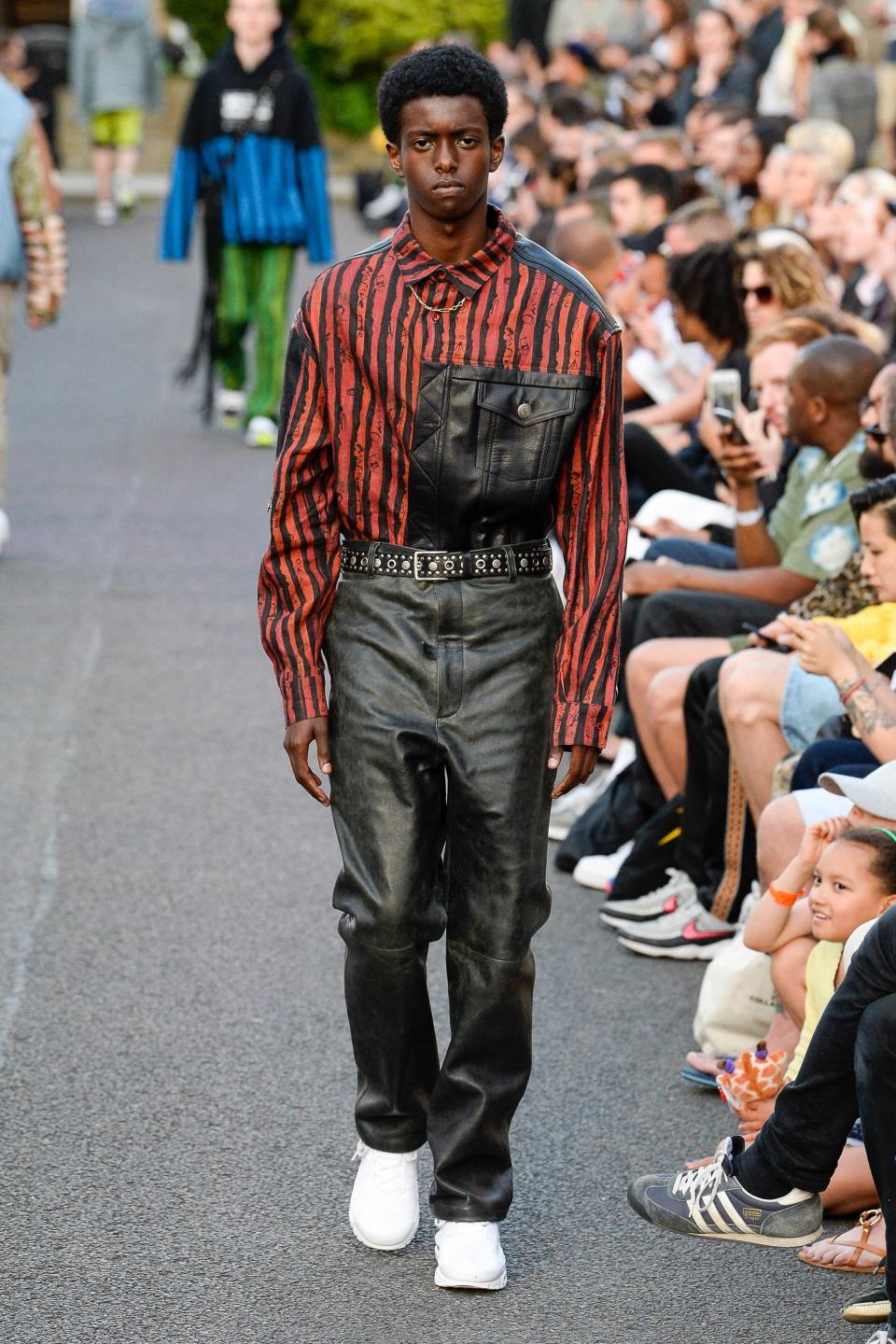
Strange—strange good, in this situation—are the emotions you feel when a designer’s show, in this case spring 2019 from Martine Rose, intersects with your own past. Rose presented her collection at St. Leonard’s Square in the north London neighborhood of Chalk Farm, with the designer inviting everyone who lived on the square to the show along with the fashion world’s usual suspects. That resulted in this, wrote Nick Remsen in his review: “One man parked himself in the front row, his three granddaughters giddy at his side, clutching stuffed animals and sitting on the asphalt in an awestruck huddle. Another group drank red wine in their garden, happy to let the scene play out while enjoying the last rays of a warm summer Sunday. Virgil Abloh and Luka Sabbat were there, too.”
When we talk about community and inclusivity, as we rightly do and should, it’s Rose’s show that we need to be thinking about. Not just for her design brilliance—that leopard bomber jacket; those shirts and pants scrawled and daubed with stripes—but also for the way she made the experience of fashion available and accessible to all. Her vision of what we might want to wear is never divorced from the quotidian experiences of 21st century London—hers, and that of so many others.
When I saw the runway images, I knew that street, because I had walked down it, and hundreds of others like it, when I lived in north London in the late ’90s. I was in a garden apartment on a tiny street which snaked alongside a canal, the sidewalk punctuated with wonky Victorian streetlights, which sometimes worked, sometimes didn’t. The street was bookended by a busy road thundering with trucks at one end, a seedy lane with a massage parlor of colorful repute at the other. Rose’s show brought me right back to those pre-New York years of mine, back to London, and to all the good and progressive and positive things about the city. It took me back to life, back to my life.—Mark Holgate, fashion news director
Gucci resort 2019
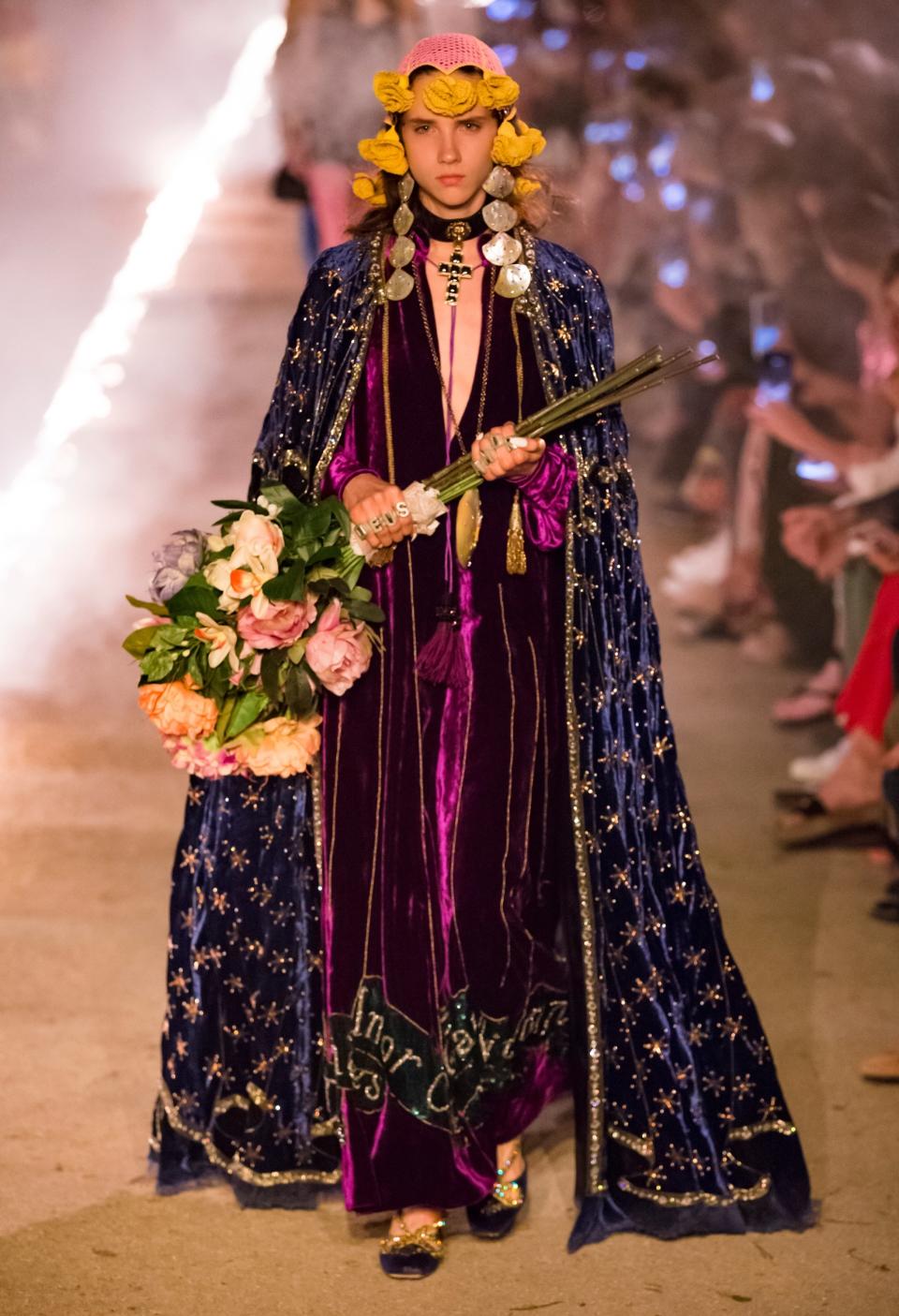
“If you remember Woodstock, you probably weren’t there,” the old joke goes. But what if you swear you can remember things, and you know you weren’t there? I was 4,000 miles away from Arles, France, when Gucci held its resort 2019 collection on the Promenade Des Alyscamps, the final resting place of Roman bigwigs buried here two millennia ago—and yet I can almost feel the squishy, spooky leaves beneath my feet.
“The inspiration is an ossuary, the crypts of the cardinals, of the monks in the 15th century, and the precious decorations,” Gucci’s creative director Alessandro Michele declared on Instagram before show time. “This idea is that everything that is linked to the afterlife is accompanied by something of maximum beauty. It’s the idea of death as fascination.” But what about life as fascination? A life that could bring you to the south of France to a graveyard at dusk, to sit on a mirrored box and witness ensembles set amid tombstones? (As it happens, Michele is not the only angel of death floating above fashion: in September 2018, Rodarte held its show in a Lower East Side cemetery; way back in 2001, Imitation of Christ commandeered a downtown funeral parlor.)
“And death shall have no dominion,” Dylan Thomas wrote in his famous poem, quoting St. Paul’s epistle to the Romans. “Dead men naked they shall be one.” Sir, may we beg to differ? They will not be naked! According to Michele, they will come clad in velvet Gucci gowns with skeleton thoraxes embroidered on their bodices, they will hide behind Gucci face coverings meant to evoke ancient death masks, and even their sprightly limbs will be covered in Gucci leggings emblazoned with the words memento mori.—Lynn Yaeger, contributor
Christian Dior fall 2012 haute couture
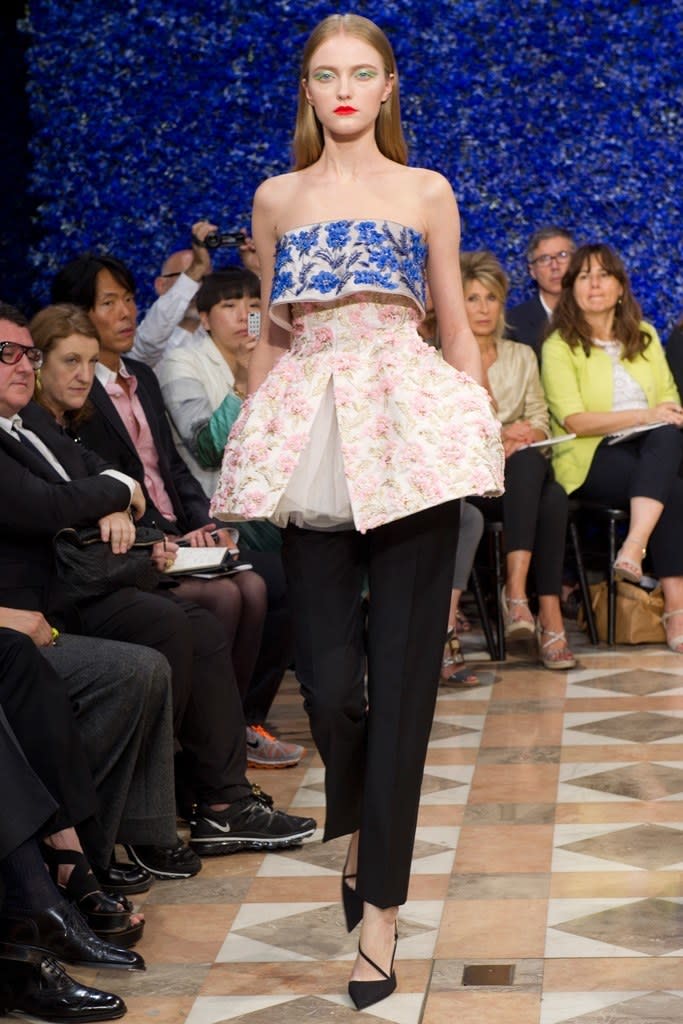
Allow me to start with the setting: each salon paneled in floor-to-ceiling monochromatic flowers: What was the fragrance of all that mimosa? How did it feel to run one’s hands over so many tightly packed orchids? The backdrop of deep blue delphiniums from the runway photos remains breathtaking to this day. Of all the outstanding sets I have had the privilege of experiencing (i.e. seasons of Chanel shows), the tastefully maximalist concept and execution by Bureau Betak along with florists Mark Colle and Eric Chauvin will be forever imprinted on my mind’s eye. Shifting focus to Raf Simon’s lineup, I remember the frisson I felt upon seeing the embroidered ballgown-turned-peplum paired with black cigarette pants, followed further on by the actual gowns that, thanks to Sterling Ruby, were exceptional works of contemporary art. And watching it online, I instantly admired how Simons transposed the codified rigor and elegance of the Christian Dior language onto his own, cerebral yet pared back Antwerp aesthetic. This was haute couture that not only struck me as relevant, but seemed as though it would have a ripple effect for some time to come.—Amy Verner, contributor
Craig Green spring 2019 menswear
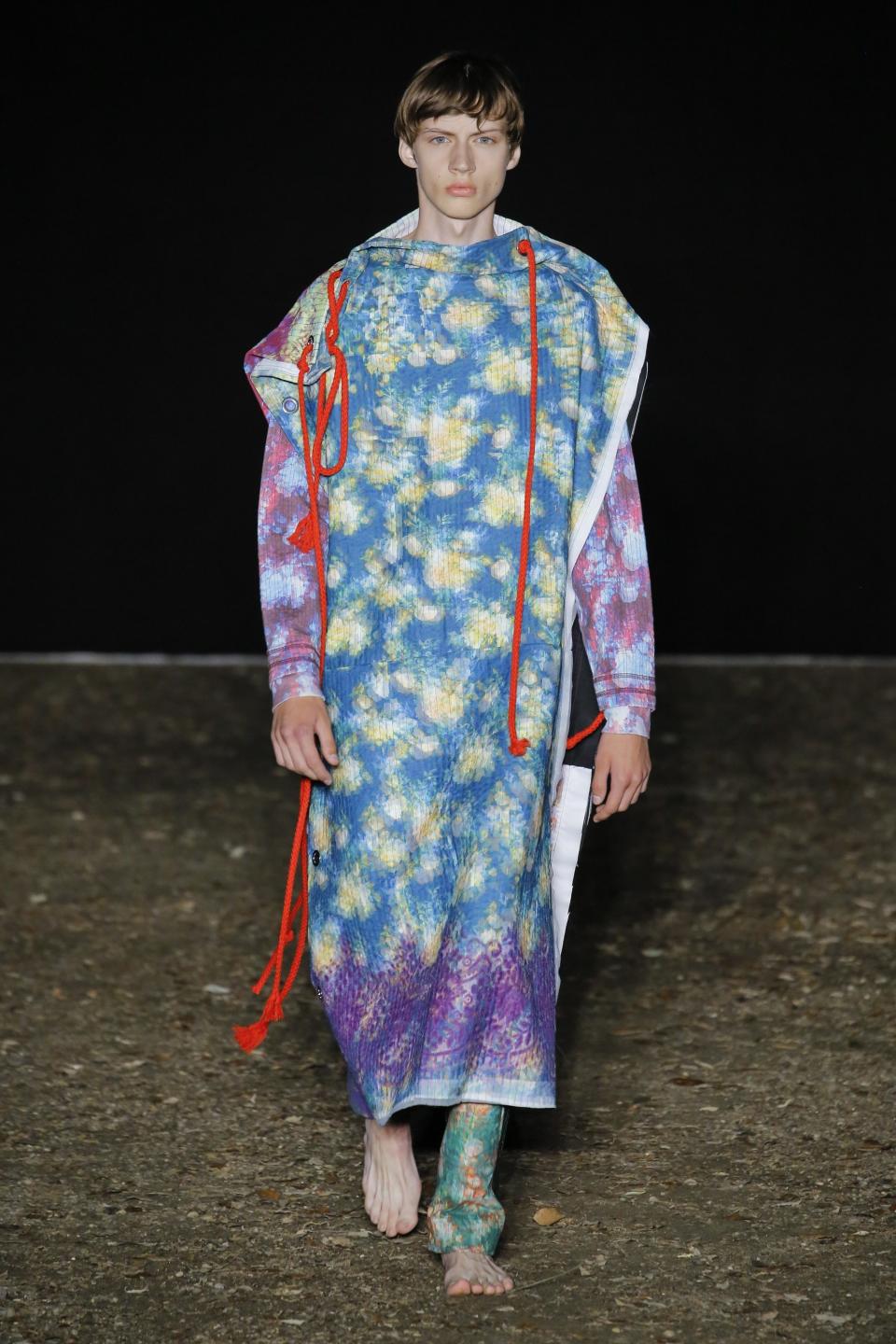
I know my colleagues will put together a list of the decade’s most incredible womenswear shows, so I feel the need to register my great menswear FOMO that happens every January and June. There are so many shows I wish I could have seen—Kim Jones’s first at Dior, Matthew Williams’s latest at Alyx, Haider Ackermann’s short but resplendent stint at Berluti, Rick Owens’s pantsless men!—but the one that cuts deepest is Craig Green’s spring 2019 show at Pitti Uomo in Florence. I remember seeing the images come in to our Vogue Runway server, electric colors and haunting human silhouettes. There was technical innovation in the form of Nike FlyKnit clothing and a kind of spiritual resonance through the set—the show was held at night—and through Green’s meditations on reality, fear, and heaven. Our colleague Sarah Mower described it as “transcendent.” You get the sense it really was transcendent through the images, but what I would give to have been there in the flesh!—Steff Yotka, fashion news editor
Marc Jacobs, spring 2015
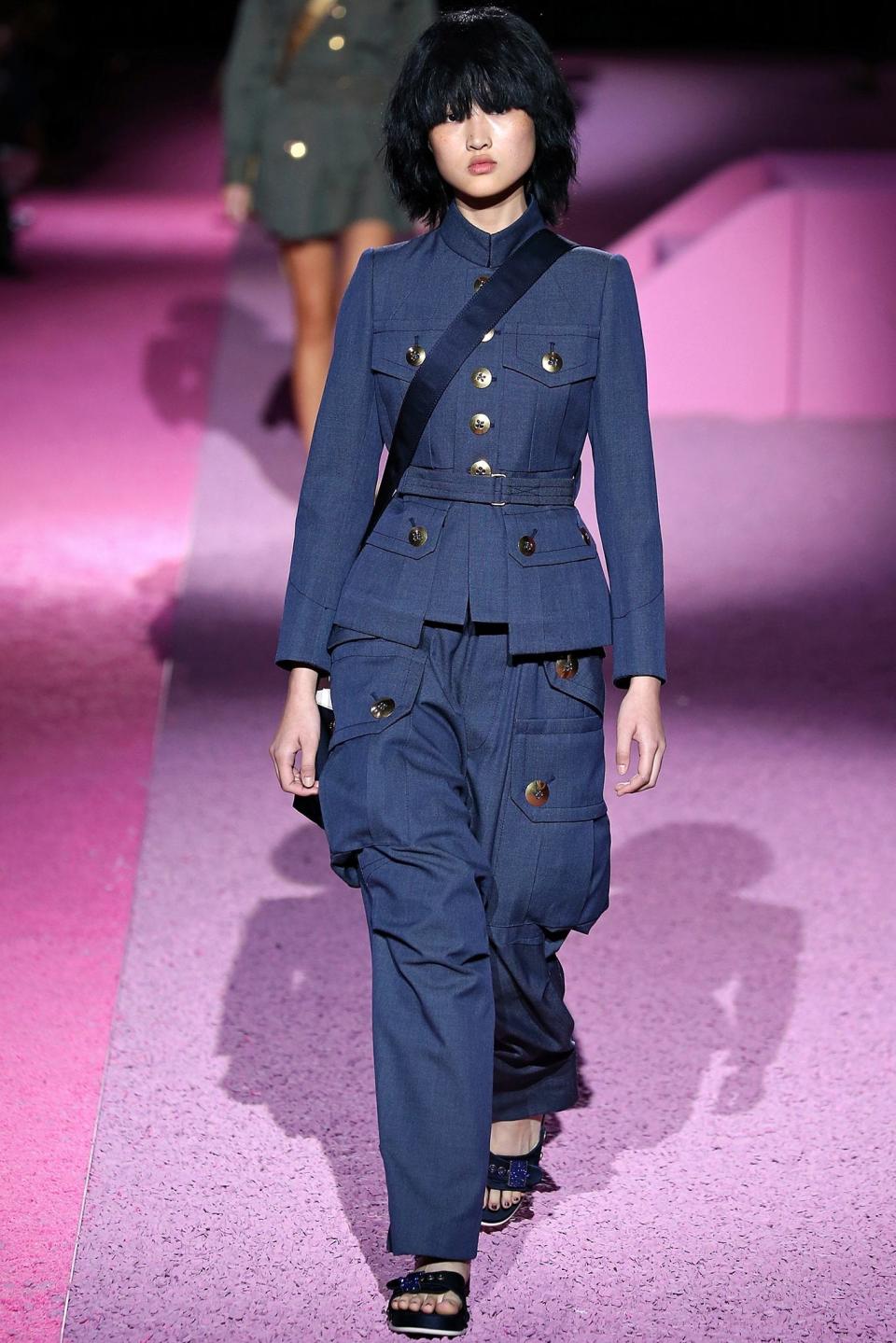
Back when I used to cover New York, Marc Jacobs was the one—the show. (I’m pretty sure he still is). Anyway, back then Jacobs was also the last show on the schedule, which meant if you were British and needed to get back to London, pronto, you had to take your luggage, see the show, and head straight to JFK for a red-eye. Jacobs famously started on time so I left my hotel an hour early. Within minutes the guy driving the town car shared some bad news—he’d just discovered he had an illness—as he took two wrong turns into a cataclysmic gridlock impressive even by Manhattan standards. The driver’s plight put mine into perspective, of course, but it was my job to be at that show. We arrived outside Jacobs in time to watch the audience leave. JJ Martin—in her pre-mogul phase, and then in the trenches for Wallpaper* magazine—gave me the low-down: “Well, this show started at 6:01pm precisely. But you already know that, huh? It was remarkable, and not only for the enormous Pepto-Bismol house that was the stage, or the pink shaggy rug that surrounded it. This is the first fashion show I have been to where they handed out individual headphones for each guest, provided by Dr. Dre, so we each had our individual sound system… The clothes were creative hybrids: dresses that spouted capes and cargo pants that turned into culottes. A lot of designers like to say they’ve reinvented something or other’ but today I have to say Marc did reinvent the cargo pant.” Even if this maybe wasn’t his greatest collection ever, Jacobs is, I reckon, the best American womenswear designer on the block—so I still kick myself for missing that show.—Luke Leitch, contributor
Ann Demeulemeester fall 2013
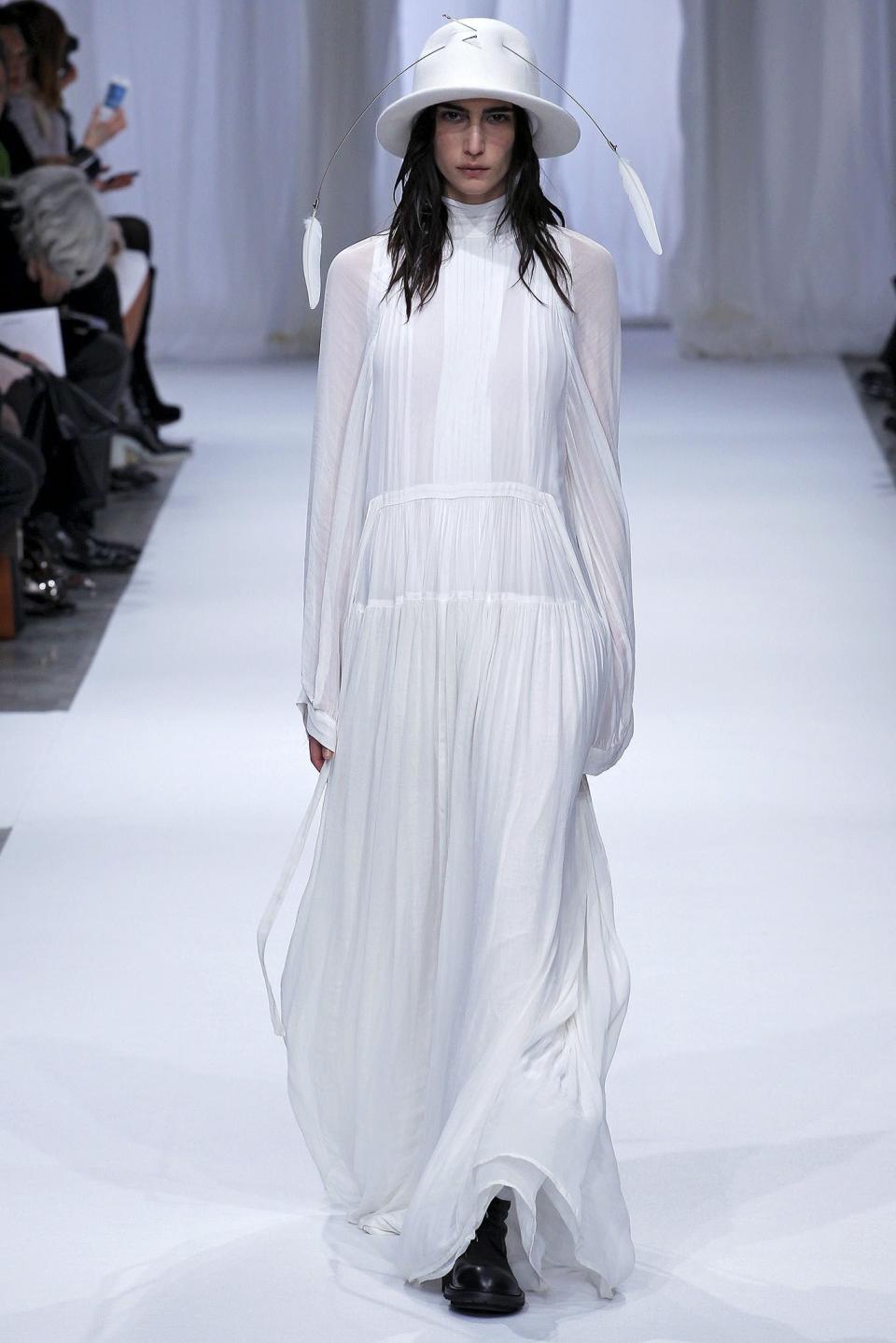
It’s possible that I am Ann Demeulemeester’s most unlikely fan; lacking both the rebel attitude and willowiness necessary to really carry off her clothes. But hey, they make this girl dream. The purity of the opening looks of Demeulemeester’s fall 2013 show (which would end up being her last fall outing before she retired) had the kind of wafty romance—and, of course, feathers—that fueled my devotion.—Laird Borrelli-Persson, archive editor
Savage x Fenty spring 2020
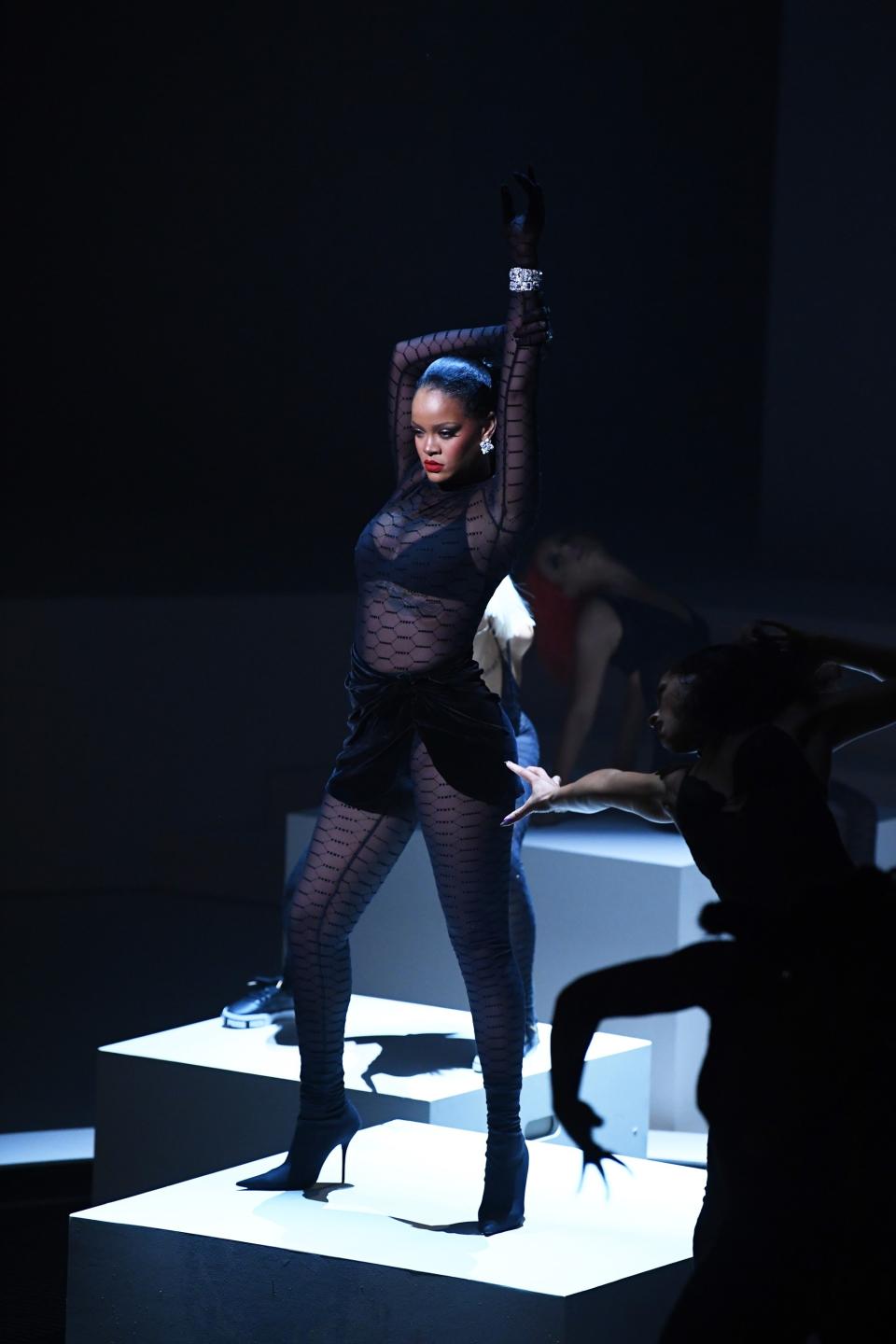
I thought I had a good excuse for missing the Savage x Fenty show at Barclays this season, but after re-examining our dizzying grid and looking back at the weather, I think I was just tired... and behind on reviews. Brooklyn felt like a long way to go at 9:00 p.m., so I chose to skip it—and around midnight, when everyone reclaimed their phones at the door, a stream of videos flooded my Instagram. “Epic!” “What the Victoria’s Secret Fashion Show should have been,” wrote friends and colleagues. I knew I’d missed out. When it aired on Amazon Prime a couple weeks later, my friends in New York, Chicago, India, and beyond texted me to ask if I was there. I should have been! The range of models, dancers, and celebrities of different body types, sexual orientations, and personalities was indeed epic. It was the rare show that resonated with “fashion people” and the general public alike, and I know its impact will be longterm and far-reaching. In a few years (or sooner, hopefully), all runway shows will look like this, but it would have been great to witness it all firsthand—the body positivity, the sex positivity, the unabashed feminism. Bella Hadid, Cara Delevingne, Laverne Cox! And, of course, Rih. It was a show that would have stayed with me for seasons to come, and that’s the real loss.—Emily Farra, senior fashion news writer
Yeezy fall 2016
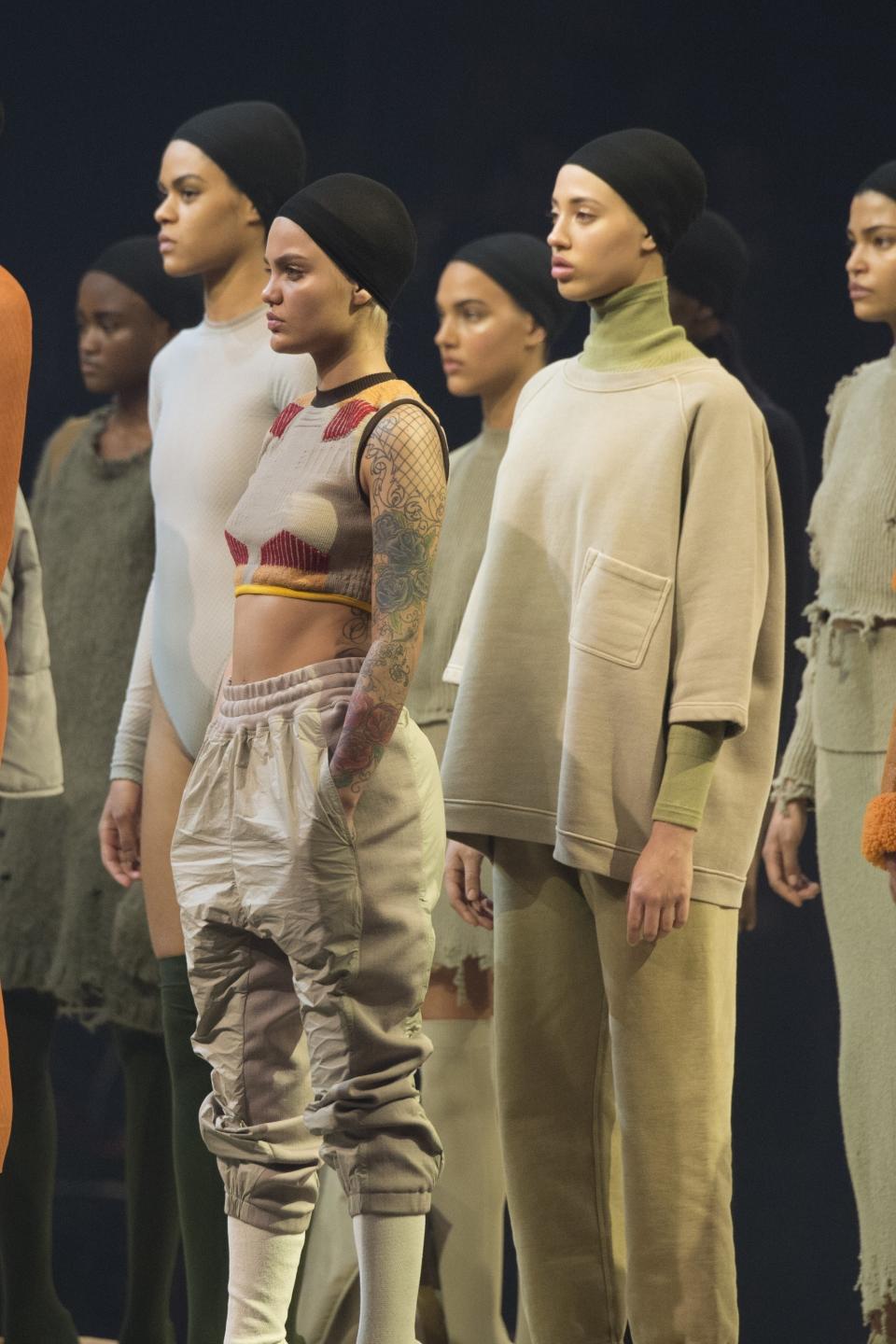
As much as I think Kanye West has since completely lost the plot, I do regret missing his fall 2016 Yeezy show and listening party for The Life of Pablo at Madison Square Garden. There’s the sheer spectacle of it all, but also it was the very definition of disruptive: bringing together Hollywood icons, music moguls, reality T.V. stars, and the fashion community, and blurring not just mediums, but gender lines and high-low fashion. I would imagine that it really made other designers and brands rethink the traditional structures of the fashion show.—Brooke Bobb, senior fashion news writer
Dries Van Noten spring 2020
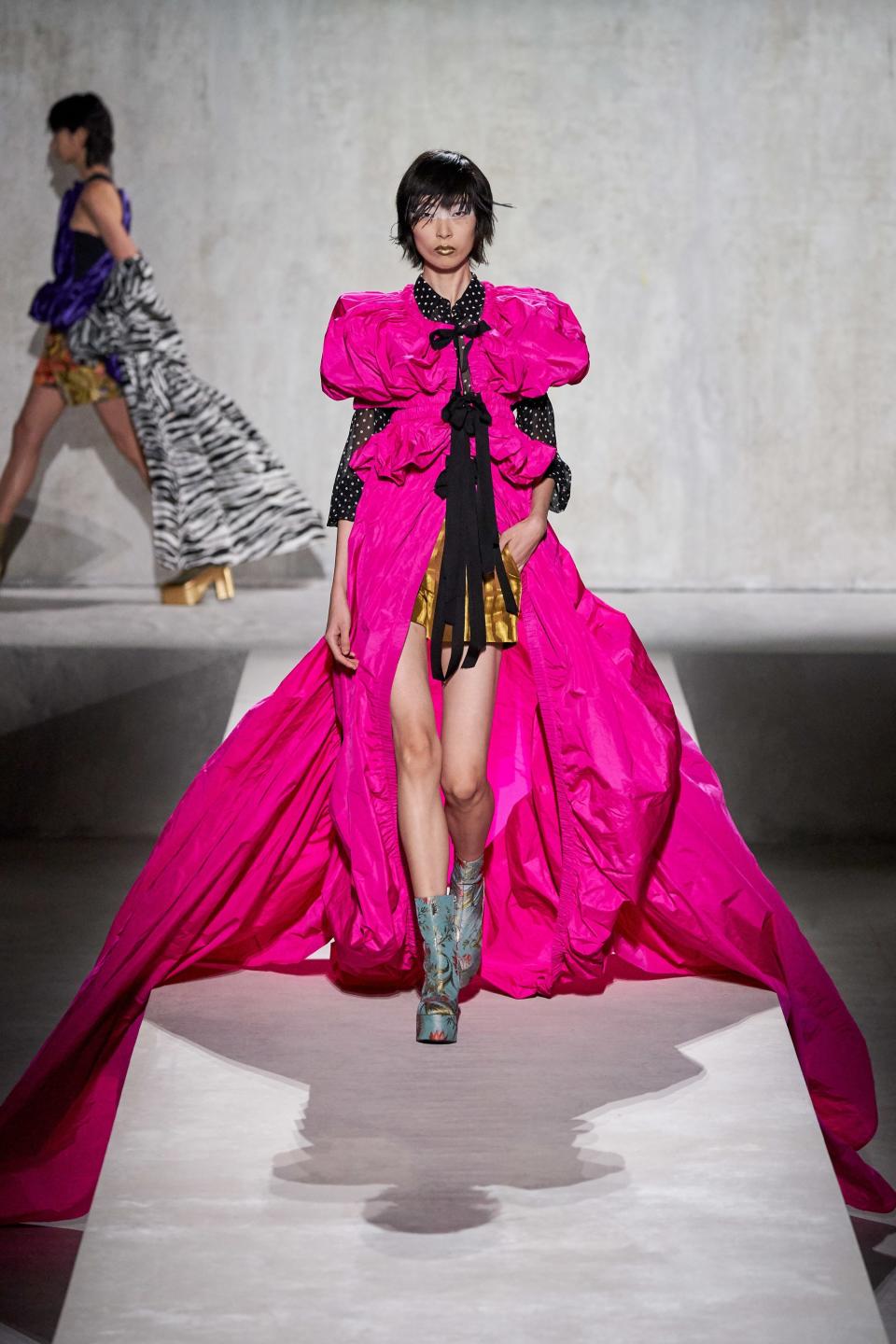
I first met Dries van Noten and Christian Lacroix at about the same time, but their fashion worlds could not have been more different. In 1986, Dries had been invited to show during London Fashion Week as the fairly bleak Olympia fashion fair in a collective with his fellow Belgian designers soon to be known as the Antwerp Six. Gracious though the invitation may have been, when they arrived the young designers discovered that their stand was positioned behind the mass market wedding dress section so that their wares were hidden behind an embarrassment of Lady Diana scaled synthetic satin and tulle crinolines. Ever pragmatic, the designer friends raced to print up cards and flyers and handed them out by the escalators to attract attention. Intrigued by the buzz and the enthusiasm of my prescient fashion assistant Lorena Crosland I went to see what all the fuss was about and fell in love with Dries’ menswear collection of Edwardian boating blazers and well made antebellum-style accessories. Bonnie Pressman from Barneys was struck too, and asked Dries to add a skirt to the line—one long, one short, in fact —so that she could sell the collection in the store’s women’s department. He obliged, and his womenswear line was born. Meanwhile, on the rue Saint Florentin in Paris, wunderkind Christian Lacroix was whipping up fanciful confections for the storied House of Jean Patou—puff balls and Baby Dolls styled to accentuate his partner Francoise Rosenthiel’s comely bosom and shapely legs. I was giddy with excitement. Over the years, each designer matured and brought their respective skills to developing brands that would come to define the moment, and to creating fashion shows that would make the heart and the imagination sing and soar.
I had seen Dries and his partner Patrick at a friend’s birthday on Capri just before spring 2020 Paris fashion week, and Patrick had quietly suggested that he thought I would particularly enjoy their upcoming show. The enigmatic Dries said absolutely nothing. However, I was to be in Rome on assignment on the day of their show, so I raced to look at it on Vogue Runway. The first look struck me as unusually whimsical and dare I say, Lacroix-ish? Through look after look the Lacroix influence grew. Young designers from New York (Christopher John Rogers) to London (Richard Quinn), were riding an exuberant Lacroix wave—and why not go euphoric in dark times?—but I was surprised to see Dries embrace the vibe so enthusiastically. But then his own print mixes and respect for the history of dress married to the practicalities of the modern woman seemed like a good mix with Lacroix’s aesthetic, and the blending seemed to crescendo into the final looks, where Belgian tailoring married brilliant faille clouds of Parisian romance. All was revealed and explained in the final image where I saw Dries take his bow with Christian. Two gods of style collaborating in generous and joyful harmony: absolute fashion magic to celebrate the new decade.—Hamish Bowles, European editor at large
Originally Appeared on Vogue

